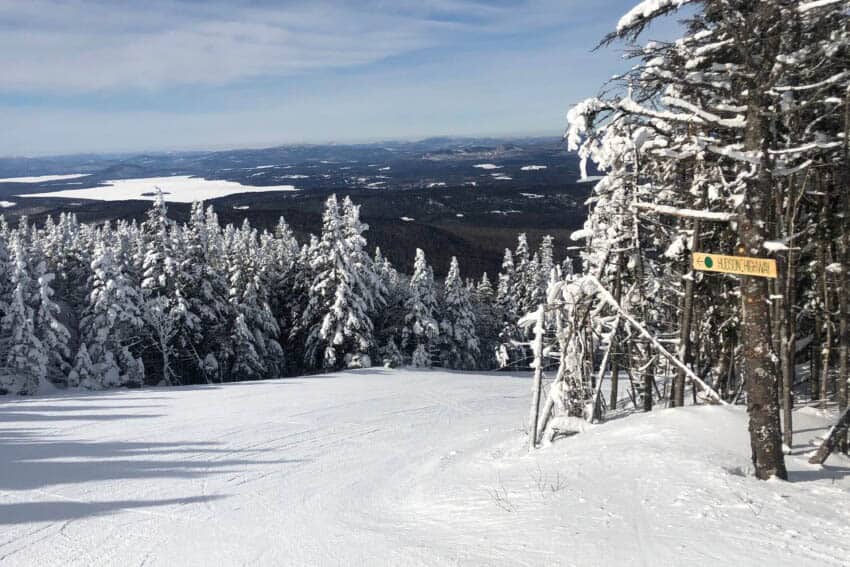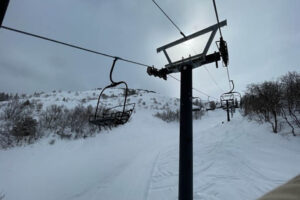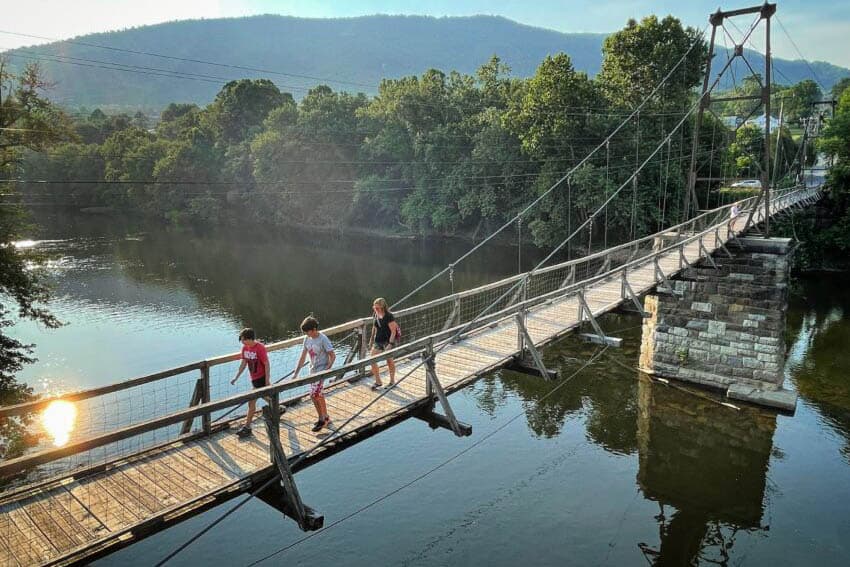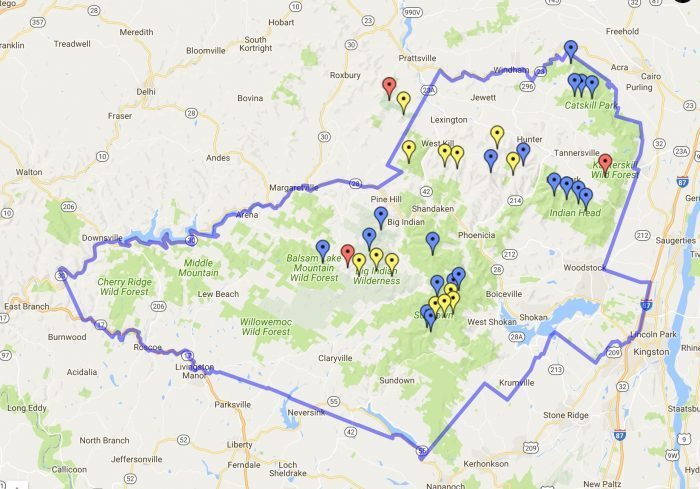
A summary of 10 years hiking in New York state’s Catskills with the 3500 Club
By Sonja Stark
History is best understood by walking the ground where it happened, says filmmaker Ken Burns. No better place does that wisdom apply than in the Catskill Mountains of upstate New York.
Rutty carriage roads, serpentine stone walls, rotting hemlock: these are the early traces of an industrial age that burdened miles of unprotected forests. Today, they’re cairns for hikers mapping their way through the 35 highest peaks. I was one of those hikers.
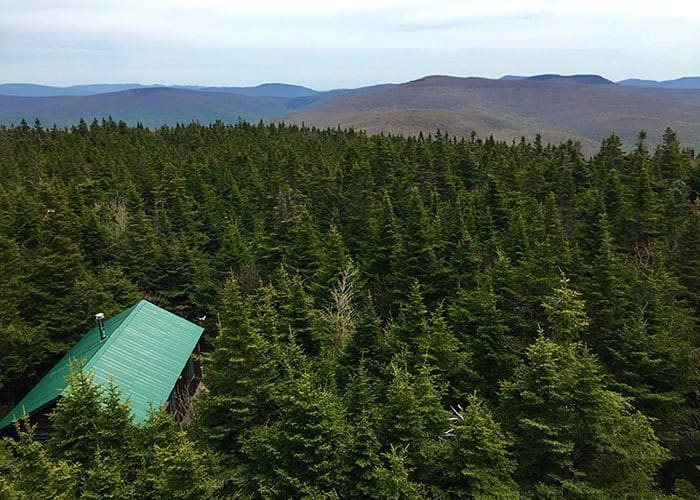
My favorite trails culminated with scenic vistas from restored fire towers like Balsam Lake and Hunter. I also enjoyed bruising bushwhacks past airplane crashes on Friday, Doubletop, and Kaaterskill mountains. With so much to see beforehand, rarely did I race to the top. With 700,000 acres of mountains, forests, rivers, and farmland scattered over five counties, exploration of this magnitude took time.
“America’s First Wilderness” deserved plenty of photography too. Typically, I kept to the back of the conga line when I hiked with scheduled groups. It wasn’t that I couldn’t keep up, often I’d get lost in contemplation. It’s easy to reflect on how a culture of the industry, conservation, and tourism shaped the area.
The Crowning Achievement
I finished all 39 climbs (4 repeated in the winter) atop Fir Mountain during a late December blizzard with Rick, my post-hole pacesetter. Post-holing is slang for hiking in deep snow without snowshoes or skis, leaving large holes behind you. (Clarification: We only post-holed off-trail! Doing so on an actual trail will get you shamed off the mountain.)
As a result, Rick burned through twice as many calories and fought off a layer of snow sticking to his glasses.

While the winds howled, bright pink ribbons (not of our doing) helped guide us to the canister. Otherwise, pink ribbons are an absolute ‘no-no’ says Membership Chair, David White.
Bushwhacking demands, first and foremost, excellent compass skills. It’s also important to streamline your pack, stay a pole length distance between you and your partner, wear glasses to avoid scratches, and on rare occasions turn and push yourself backward to make your way through a thick bunch of branches.
An ominous crack from a dying Sugar Maple sent me scurrying to stay close. What a tragedy it would be to be the victim of a falling deciduous.
The goal took 10 arduous years and looking back at my blog entries, it’s neat to see how much I learned. Not all of it was fun and games though.
I got lost on Kaaterskill, torn to shreds by stinging nettles on Halcott and suffered frostbite on Hunter. I was scared silly by bear tracks on WestKill and beat up by branches on Rocky.
But opposing energies always prevail in a hiker’s universe. On the plus side, I sipped tea with strangers on Slide and watched rare cottontails give chase on Balsam Lake. I enjoyed a bumper crop of blueberries on Blackhead and made my boyfriend a believer in Balsam.
Steep trails turned into gentle switchbacks. Sunbaked logging roads morphed into cool and hospitable herd paths.

The pretty and gritty provided greater insight and perspective on my place in this pristine environment.
In the Beginning
It all started in 2007. That was the year I began efforts to keep up with hiking savant, Nola. Admittedly, I’m not the hiking junkie that my friend is, nor ever will be. She made it look so easy, pulling her tiny self up a big rock by tree roots effortlessly.
On one rainy Sunday in early June, with black flies circling and cold rain pelting, I followed Nola up Wittenberg and Cornell. A medical condition in my kneecaps screamed for mercy but I masked the pain enjoying spectacular views of the Ashokan Reservoir.
While the hardy profess to prefer the Adirondacks, my level of addiction has always been happy with the gorges and waterfalls of the Hudson Valley. Five years in, I was signing up for brambles with veteran members of the Catskill 3500 Club. I invested in better gear and bought works by local authors Carol White, Michael Kudish, and Alan Via.

A spirited Winter Weekend at the Frost Valley YMCA allowed my friend Elizabeth and me to thaw out in a Japanese soaking tub after Panther.
A Forest Timeline
It’s no surprise that the legendary forests had a preternatural pull on generations of entrepreneurs, artists, writers, and poetics. One of America’s foremost nature writers, John Burroughs summed it up: “I go to nature to be soothed and healed, and to have my senses put in order.”
True story: One harrowing day in April 2015, I wandered onto the exact same spot where, in 1866, famous Hudson River School artist Asher B. Durant stood with canvas in hand. He painted an idyllic view of Kaaterskill Clove.
This was shortly before finding my way into a circa-1883 retreat called Twilight Park. Homeowner Bernie was quick to point out a USGS survey marker from 1708 marking the original boundary with the native tribe. To think, I stumbled onto this hotbed of rich history hopelessly lost on Kaaterskill.
Bark Peelers at Work
But, deep respect for the area’s verdant landscape wasn’t always the case. Between 1800-1900, human impact raped the hillsides to feed the economies of growing industries like logging, leather tanning, and mining. A unique bluestone was quarried for the construction of NYC sidewalks.
Pioneers took blades to countless giant Eastern hemlocks for the tanning trade. Once boiled, the tannins in the bark helped cure animal hides into leather for the manufacture of soldier boots, horse saddles, and harnesses. Conservation movements and forestry laws weren’t around to save the 300-year-old evergreens from toppling, some that kissed the sky at 100 feet.
It takes a keen eye but you can find forgotten piles of bark gathering moss not far from the escarpment slide atop Doubletop. And, if you’re good at tree spotting there are first growth giants still growing, saved from being barked, farmed or burned.

Living History
It’s not a high peak but I learned a lot about quarries and tanneries hiking the Tanbark Trail in the town of Phoenicia. The 2.3-mile route, steep but manageable, comes with interpretive signage and nice views. While the nearby new Maurice Hinchey Catskill Interpretive Center offers a series of oral accounts, artifacts, journals, and books to enrich your connection with the Catskills.
Historians at the facility like to talk of beamed houses, barns, and grist mills that gave way to thriving hamlets like Tannersville, Prattsville, Shandaken, and Claryville.
Maps tell of a newly-minted railroad industry that spurred the building of great Mountain Houses allowing Manhattanites an escape from a concrete jungle. Those hotels burned to the ground eons ago, but, today, thanks to the popularity of Governor Cuomo’s tourism campaigns, there’s a reawakening of the same aesthetic inspiration.

Hotels that Matter
39 climbs later, it was impossible to pick a favorite Catskill peak but easy to decide where to celebrate my success.
Odds are I zoomed past the Emerson Resort and Spa on Route 28 near Mount Tremper dozens of times but never noting their pet-friendly accommodations. Finally enlightened to their policies, I reserved an overnight with Mom and the family pet.
Fittingly, the luxury hotel champions the prosaic philosophies of one of America’s leading voices of nature and dogs, Ralph Waldo Emerson. Posthumous excerpts of his beloved poetry adorn the walls of 26 beautifully-appointed guest suites. Sunken tubs, marble tile, gas fireplaces and dog treats included!
Spa clinics focus on staying healthy while indoor experiences include the World’s Largest Kaleidoscope and a one-of-a-kind art installation called Watershed: The Flow of Time Through Place.
At the Woodnotes Grill restaurant, Mom and I toasted the occasion with a bottle of Pinot and plates of “Catskill Creative Cooking.”
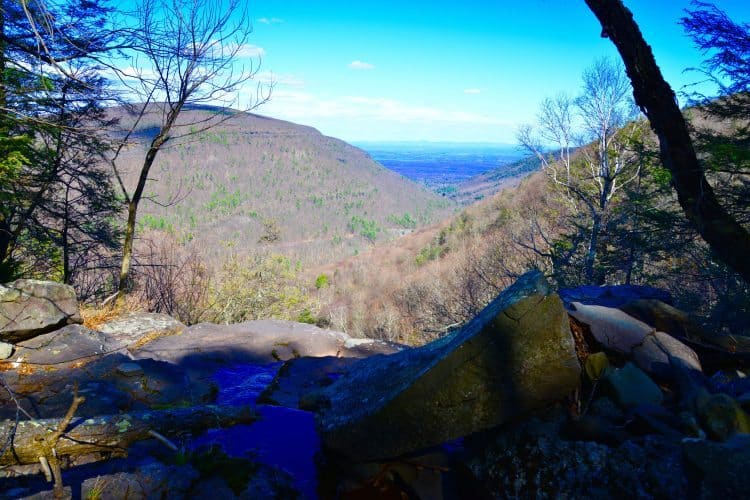
- Marseille, France: Biking to the Calanques - June 23, 2023
- Alentejo, Portugal: From Coast to Countryside - June 20, 2022
- Lake George, NY: Castles, Igloos and Ice Diving - March 20, 2022


